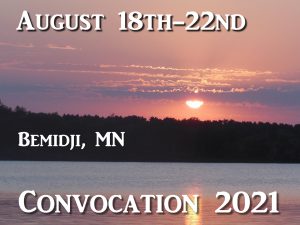Ten Years?
If the necessary preceding events fall into place within the next few years, then yes, we could be as little as ten years away.
If we interpret the thousand years of Rev 20 as literal and exact (rather than symbolic or approximate), then we have our key to the three days of Hos 6:2. The question in dispute is whether this is a key that God intends. Or is this merely symbolic of a brief period of time, as thought by most commentators?
But what is brief about two days if it represents the whole duration of the age of exile and covenant judgment? And why is the golden age of Jewish hope limited to only one day (i.e., “the third day”)? Surely a mystery is invested in this unusual usage that is set to serve its greatest purpose at the time of the end (Dan 12:4, 9).
One thing should be undeniably clear. The “affliction” of Hos 5:15 can be nothing less than the great tribulation of the latter days spoken of by Moses and all the prophets. Beginning with Moses, this transitional event was seen as the great dividing line between “this age” of estrangement and covenant judgement, and “the age to come” of ultimate covenant fulfillment when the nation’s perennial blindness would be lifted forever (Deut 29:4; Isa 6:10-11; 32:13-17; Eze 39:22, 28-29).
It is well documented that many have understood the course of civilization to be on a scale of six millennia given to the government of man (the number of man), and a seventh, millennial sabbath of the kingdom of God on earth. On this reckoning, the metaphorical third day envisions the millennium of Rev 20.
So the “third day” as the post-tribulational millennium becomes our key to the duration of the two days as the end of Israel’s covenant estrangement, and God’s temporary disownment and desertion, in the foretold hiding of His face (Deut 31:17-18; 32:20; Isa 54:8; 64:7; Hos 1:9-10; 2:23; 3:5; 4:6; 5:6, 15; Mic 3:4; 5:3; Eze 39:23-24, 28-29). If the third day begins at the end of a yet future tribulation, this can only mean that the two days must be reckoned, not from the beginning of exile in 722 B. C., but from some point approximately 2000 years before the end of the final tribulation.
The question of what determines the point that begins the two days must be something of awesome magnitude. This is strongly hinted in Hos 5:15 in comparison with Mic 5:1-3. The context assumes, not the general apostasy of the nation, such as would not discontinue seasons of blessing, even occasional revival up to the time of Jesus. No, this is something more final.
The offense that Israel is confessing at the end of the tribulation is the ultimate provocation that reached its climax in the rejection of the Son. What else would be sufficient cause for such an age long abandonment?
Hosea 5:15
I will go and return to my place,
till they acknowledge their offence, and seek my face:
in their affliction they will seek me early.
Micah 5:1-3 tells us plainly what that consummate offense was. It was the smiting of the ruler ruler from Bethlehem. Only this could evoke such solemn words that so well sum up the long and tortured history of the Jewish people.
Now gather yourself in troops, O daughter of troops:
he has laid siege against us:
they shall smite the judge of Israel with a rod upon the cheek.
But you, Bethlehem Ephratah,
though you be little among the thousands of Judah,
yet out of you shall he come forth unto me that is to be ruler in Israel;
whose goings forth have been from of old, from everlasting.
Therefore (for this cause) will he give them up,
until the time that she which travaileth hath brought forth:
then shall the remnant of his brethren return …
Commentators will typically say that the one who is smitten with a rod upon the cheek (a metaphor for cruel humiliation) was the king of Israel. (Commentators are divided as to whether this was Hoshea at the time of the Assyrian invasion, or Zedekiah at the time of the Babylonian invasion). But notice, what if the judge (ruler) of Israel in verse one is the pre-existent ruler from Bethlehem of verse two, the Messiah from David’s line?
This alone is sufficient to explain the gravity and tragic implications of what takes place as the result of the smiting of the judge. It is the age long “giving up” of the elect nation. Nothing could be more solemn and full of tragic portent. If I am Jewish, contemplating the saga of my nation’s tragic history, this verse should evoke the deepest emotion. Notice carefully the decisive connective, “therefore”, in verse three.
What is the ‘therefore’ there for? To what does the ‘therefore’ of verse three refer to as the causal source of what follows? We must ask, what offense, what momentous provocation is sufficient cause for God to use such solemn and foreboding words as these? “Therefore (for this cause) shall He give them up UNTIL the time when she who travails has come to birth” (compare Isa 13:8; 26:16-17; 66:8; Jer 30:6-7; Dan 12:1).
What cause could be so great enough for God to withdraw and hide His face? This is the language of divine desertion! This is wrath upon the “people of My wrath” (Isa 10:6; Lk 21:22-23). To answer this question is to identify a particular “offense”, not offenses (plural) or guilt in general, but ‘THE’ consummate offense (singular) that moved the Lord to “go and return to My place”.
The implications are as clear as they are profound. With the ultimate rejection of God in the person of the Son, the larger part of the nation would be “given up” until the post-tribulational birth / resurrection of the fallen nation (Isa 66:8).
[I cannot speak of Mic 5:1-4 without mentioning how beautifully typified this reunion is by the reunion of Joseph to his estranged brethren. Here, as also typified in the weeping of Zech 12:10, Joseph’s brethren come in bowed submission to their brother, exactly as in the dream that so angered them as to plot his murder. The parallels are sublime!]
With Israel’s fateful “fall” (Ro 11:11-12), the foretold stumbling at the tested cornerstone laid in Zion, as the glory of the Lord had departed from the temple in Ezekiel’s vision, so now the Lord of glory departs from the temple with the words, “Your house is left to you desolate. You will not see Me again UNTIL you will say, ‘blessed is He who comes in the name of the Lord’” (Mt 23:39). In a few days, He rises, and after 40 days returns to His Father’s right hand, there waiting ‘UNTIL’ His enemies are made His footstool.
Can this all be incidental, unrelated to Hos 6:2, so that the three days are nothing more than a mere metaphor for an indeterminate period of time? That is the question each one will have to answer in their own heart before the Lord. This is a mystery. It is somewhat hidden for a purpose. It is for babes, not for those who are wise in their own eyes.
Nothing else so well agrees, not only with the immediate context, but with the mystery of the two comings that progressive revelation will bring to light at the appointed time (1Cor 2:7-8). If the two days are to be reckoned from the death, resurrection, and ascension of Jesus, and if they are to be taken with the same literalness and exactness of the millennial third day, then, yes, we are fast approaching His return to within a decade or very closely thereabouts.
Where better to mark the beginning of the two days than the Lord’s departure to the Father’s right hand, after what Paul will call Israel’s “fall”? (Ro 11:11-12). This climactic fall and special hardening does not begin with the exile. Nor is it simply the continuum of Israel’s perennial blindness and covenant dereliction, reaching back to Moses (Deut 4:25-27; 29:4). No, this is reckoned from the time that Israel stumbled at the rejected cornerstone (Ps 118:22; Isa 8:14; 28:16; Mt 21:42; Acts 4:11; 1Pet 2:4, 6-8).
From this point, and not before, “a door of faith” was opened, as God began now to “visit the gentiles to call out from them a people for His name” (compare Mat 10:5; 15:26-27; 28:19 , with Acts 14:27; 15:14). This special, very unexpected ‘pre-tribulational’ visitation of the gentiles will continue “UNTIL” the fullness of the gentiles has come in” at the time of the Deliverer’s return to Zion. (Isa 59:20-21; Ro 11:25-27).
Note that it was well known that the nations would be blessed by Israel’s return and exaltation AFTER the tribulation. It was unknown that the gentiles would be made fellow heirs by the revelation of the gospel BEFORE Israel’s national day of deliverance. That a great installment of the promise to bless all nations through Abraham’s seed would be fulfilled while Israel yet remained in blindness and further exile was unknown and unexpected. This belonged to the mystery hidden in other ages (Ro 16:25-26; Eph 3:4-6, 9; 6:19; Col 1:26-27; 4:3).
Though not anticipated, this astonishing turn of events was nonetheless prophesied by Moses and Isaiah (Deut 32:21; Isa 49:5-6; 56:8; 65:1; Mt 21:43; Ro 10:19; 1Pet 2:10). This would be the time when an alien people (Isa 28:11), a “no people”, a “foolish nation”, would be chosen to provoke the wayward nation to jealousy (Deut 32:21; Isa 28:11; 49:5-6; 56:8; 65:1; Mt 21:43; Ro 10:19; 1Pet 2:10). How appropriate if this hidden interim should last 2000 years in agreement with the two days that exist between the Lord’s return to the Father’s right hand at the end of the 69th week, and His return to destroy the Antichrist and establish His reign over restored Israel at the end of the 70th.
The question of how literally and exactly we can take the three days of Hos 6:2 as symbolic of three millennia will depend on how literal and exact we see the thousand years of Rev 20. This will determine how literal and exact we see the two days that end with the tribulation. If, on the other hand, the thousand years is not literal, or only approximate, as even many premillennialists hold, then Hos 5:15-6:2 must be accounted for in some other way. There is no shortage of suggestions by commentators, though some old school premillennial scholars have long since held the very position we take, and this was many years before our time when the two days are now so close to expiration.
The question is what do we believe of God’s ways to hide His secrets from the wise and prudent as He reveals them to babes? Can this be such a mystery set within the text for His people to search out and detect as the time draws near? And what of the competing interpretations? Which of these do we consider would most glorify the Lord? Of course, it is the interpretation that proves true, but we are also informed by the examples of time prophecies that have already been fulfilled.
We have only to look at Jeremiah’s 70 years and Daniel’s seventy sevens. Some deny, but we have shown that these predicted numbers (except the much disputed final seven of Dan 9:27) were all miraculously fulfilled, very literally and very exactly, to the very year. This tells us something of God’s pattern of commitment to specificity and precision. This demonstration of such amazing chronological accuracy argues well for the literal and precise fulfillment of what remains. After all, when, after “the desolation of many generations” (Isa 61:4), has history ever been so ‘poised’ for the speedy fulfillment of all that remains to be fulfilled before the Lord can return?
With the second Roman destruction of Jerusalem in A.D. 132, and the many generations that the Land lay desolate, it naturally became quite un-attractive to tie the return of the Lord to a yet future restoration of Jerusalem and destruction of a yet future temple. But now, since the miracles of 1948 and 1967, we have come full circle! Exactly as the Jerusalem of the first century was a trembling cup, tilting towards ‘a’ (not “THE”) great tribulation, it is the same now again, only this time it is all the nations of the globe that will be burdened with this burdensome stone (Isa 34:8; Zech 12:2-3). The die is cast and we’re on a manifest trajectory for the full balance of all that remains. Who can deny?
So what if His return proves to be “right on time”, according to a mystery of the time indicator that lay hidden in the text, particularly, but not only in Hosea’s prophecy of the two days? Did He not expect His people to be ‘’connecting the dots” at the time of the end? (Dan 12:4, 9). Did He not say, “I have foretold you all things”? (Mk 13:23). Other than the very precise “day and hour”, is there anything pertaining to His plan that He did not most gloriously foretell?
Lest it be said that this is date setting, we ask, was Jeremiah’s 70, or Daniel’s 70 7’s date setting? Did those who received the prophecy know something certainly and definitely about the time? Will those living to see the abomination be unaware that approximately 3 1/2 years remains till His coming in the clouds? Will those living in “those days” after the man of sin is revealed in the temple know they have entered upon the final 3 ½ years? “When you therefore will see the abomination …” Both Jesus and Paul fully expect that the saints living at that time will see this event and know what follows (Mt 24:15-16, 21; 2Thes 2:4).
What of those who will see the fateful peace arrangement (Isa 28:15, 18, Eze 38:8, 11, 14; Dan 9:27; 11:23; 1Thes 5:3). Not just any peace agreement but the one that will permit the return of the orthodox to temple and sacrifice? (Dan 11:31; 12:11; Mt 24:14). Will those witnessing this not know that the door of the last seven years has just closed fast behind them?
What an advantage it will be to the bride in her preparation if she knows she has only a little while (the first half of the week) before the Jews will be thrust into the waiting arms of gentile servants and fully equipped witnesses who are prepared to receive them with love and patience, enduring the same afflictions with them, knowing their eyes are very soon to be opened.
Finally, suppose we are wrong in our interpretation. Does this set us up to be ‘date setters’, further discrediting the testimony? Not if we understand what Daniel, Jesus, Paul, and John give as essential preceding criteria that will either qualify or dismiss our interpretation well in advance of any potential false alarms.
Here, we are greatly safeguarded against premature declarations. If the two thousand years (the symbolic two days) pass uneventfully. If by a certain time there has been no temple and no sacrifice, then we have only ventured a reasonable, we think God glorifying, interpretation of the text. Our case is no case at all unless a great deal of preceding fulfillment follows very soon in due order, since 2000 years since Jesus’ departure is almost upon us. But again, how approximate was Jeremiah’s 70, or Daniel’s 69? (Reference the detailed chronology laid out in the Simple Layman series on YouTube. I forget which sessions).
Until such confirming events are clearly in view, we must be committed to caution. Both Jesus and Paul give one particular sign on which all else depends, and even this will not come without much that must precede, namely, a disarming peace agreement that permits the return of the regular sacrifice on mount Moriah. So a lot must happen in order for all of this to fall sufficiently into place in the time that these compelling considerations lead us to expect.
In any event, we are safeguarded by this: Our interpretation can be no better than these necessary, verifying preliminarily events. Can so much be fulfilled in so short a time? It will be a wonder to behold! But God is well able. And it just may please Him to wait till very late to move the political mountains that make such a swift transition appear most improbable. I think here of the suddenness with which the Berlin wall came down with the overnight fall of the Soviet Union.
Romans 9:28
For he will finish the work, and cut it short in righteousness: because a short work will the Lord make upon the earth.
Nonetheless, for many more reasons than brevity will permit, we feel quite sure that such a literal and precise fulfillment is how the Lord has chosen to most wondrously vindicate His faithfulness to foretell all us “all things”, even this. (Amos 3:7; Mk 13:23; Acts 26:22-23; Rev 10:7).
If the two days are reckoned from the cross and the ascension. If they are not approximate but represent two thousand years exactly, this would suggest that as early as the last year of the next administration’s term in office, we could be seeing the start of the final seven.
How will this be recognized? If we have understood correctly, the final seven begins with a deceptive peace arrangement. History has seen many of these, so what distinguishes this from all others?
It is the recognition by many nations of Israel’s covenant right to practice their religion at the designated location in Jerusalem (Dan 9:27). Therefore, if this is indeed the peace that seduces Israel into a fatal false trust (Isa 28:15, 18; Eze 38:8, 11, 14; Dan 8:25; 9:27; 11:23-24; Mt 24:15-16; 1Thes 5:3; Rev 12:6), it will mean that very soon after this agreement has been ratified, preparations to begin the regular sacrifice will shortly follow.
Not only this, but according to a much disputed portion of Daniel’s prophecy (Dan 10:14-12:13), most commentators (certainly not all) assign to antiquity much that remains still in the future. This is not the place to make the case, but the evidence will show that Dan 11:21 introduces the Antichrist who is only partially and very imperfectly pre-typified by the Syrian tyrant, Antiochus IV, of the second century B.C. It is the Antichrist himself that places the abomination in Dan 11:31 (with Dan 12:11), and exalts himself above all that is called God or that is worshipped in Dan 11:36-37 (with 2Thes 2:4).
This suggests that the first half of the week begins with the league / alliance of Dan 11:23. (“AFTER the league made with him he shall work deceitfully and come up and become strong with a small people”). This means that from Dan 11:23-31, we have the first half of the week covered in amazing, very observable detail that will further confirm the time, predicted event following predicted event (a play by play sequence). This will give the believing observer a clear countdown of preceding events leading up to the abomination.
What will this mean for the prophetically informed saints for their crucial preparation and witness? Everything! It will be priceless! Time fails to begin to touch on all that God has invested for our help by telling us all things in advance when we are about to enter upon the greatest global hardship in the history of the planet. Through the power and clarity of the spirit of prophecy (Rev 19:10), it will be the church’s finest hour (Dan 11:32; Rev 12:10).
I heard a well meaning friend’s complaint that scripture couldn’t possibly intend a literal temple and literal sacrifice because this would be too “formulaic”, too easy for all to recognize. Well, as convincing as this line of reasoning may sound, it fails the test of what I like to call, “the plain person’s plain reading of plain language.”
Never mind this being too obvious. The scripture is clear that despite being put on open display, the true spiritual meaning of these things will utterly elude the wisdom of this age. And that is just the point. These things will NOT be “done in a corner”! On the contrary, the greater the visibility and accessibility of these public events, the greater accountability and exposure of the heart, but also the greater usefulness of the miracle of prophecy for the instruction of an innumerable multitude (Dan 11:33; 12:3 with Rev 7:9, 13-14).
Yet, for all this, the holy messenger says to Daniel, “Many shall be purified, and made white, and tried; but the wicked shall do wickedly: and none of the wicked shall understand; but the wise shall understand” (Dan 12:10). This makes perfect sense of how it is that so late as the 6th bowl, the Lord’s return will yet come upon the unsuspecting wicked as a thief, signs, wonders, and the most prolific fulfillment of prophecy notwithstanding (Rev 16:12-16).
Yours in the Beloved, Reggie




